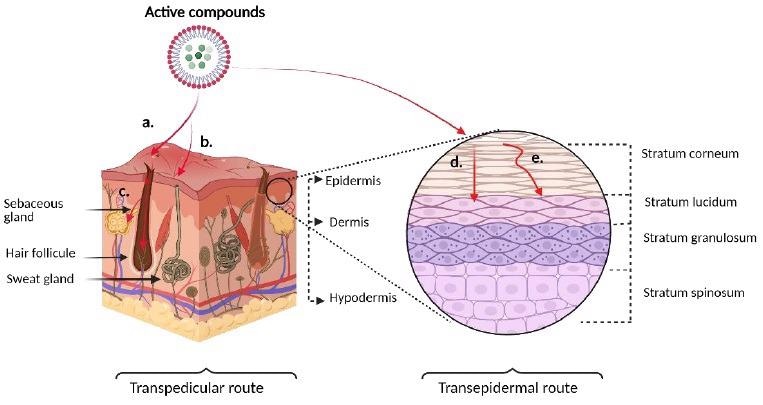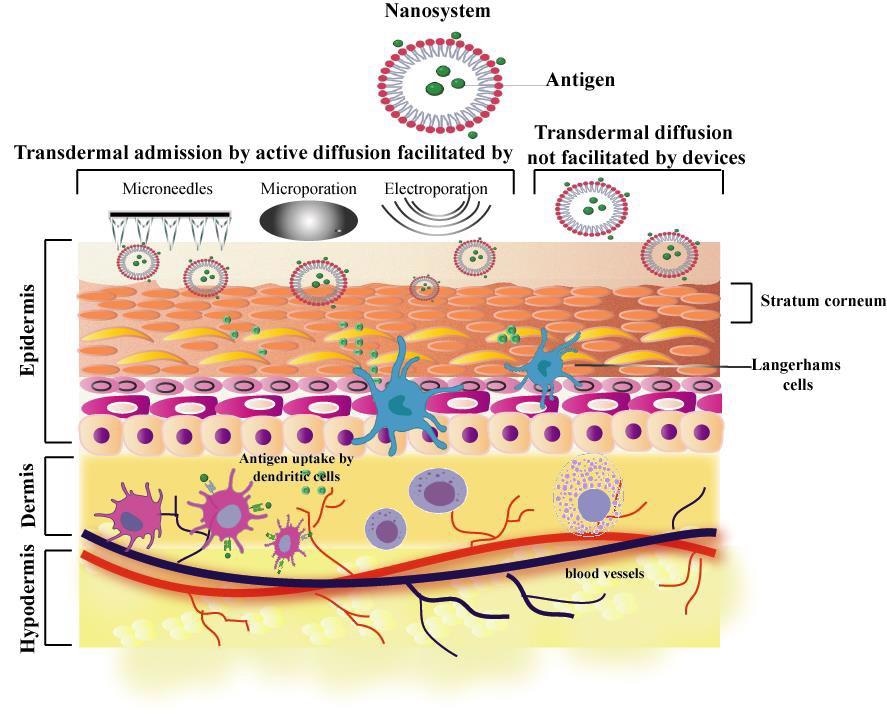The World Health Organization has estimated the SARS-CoV-2 (COVID-19) pandemic to have caused more than 5.3 million deaths worldwide to date, and with the emergence of new variants, the urgency of effective immunization has never been more critical.

Study: The Importance of Nanocarrier Design and Composition for an Efficient Nanoparticle-Mediated Transdermal Vaccination. Image Credit: BaLL LunLa/Shutterstock.com
Alternative means of effective delivery have been explored in a recently published article from the journal vaccines, highlighting how nanomedicine can aid the effectiveness of transdermal antigen delivery.
Why is Effective Immunization Necessary?
The COVID-19 infection caused by the severe acute respiratory coronavirus 2 (SARS-CoV-2) has been catastrophic for the global population, with high rates of morbidity and mortality.

Schematic representation of the routes of skin penetration of active compounds. On the left, a transpedicular route consists of a. entry through hair follicle, b. entry through sweat glands, c. entry through sebaceous glands. On the right, transepidermal route. d. Transcellular pathway, e. Intercellular pathway. Image Credit: Valdivia-Olivares, R., et al
The World Health Organization has estimated approximately 19.4 million infants globally have not been provided with vaccines. As the severity of the pandemic continues, the health of these children is at increased risk for deterioration.
This has led to the need to find alternative routes for immunization, which are effective and safe.
Benefits of Transdermal Administration
Transdermal routes of antigen delivery consist of a topical application to the skin where the active ingredients are absorbed systemically.
This type of method can be beneficial as it reduces first-pass metabolism and reduces the level of adverse effects. Transdermal administration provides an easy, simple, non-traumatic alternative that allows for self-administration, making this delivery route more attractive than the traditional injection method that involves needles.
However, a challenge for this delivery route for vaccine development consists of the protective barrier of the skin and the associated difficulties with overcoming the stratum corneum to enable antigen absorption.

Schematic representation of the mechanisms involved in immunization based on nanoparticles, either using combined techniques or design of nanoparticles by passive diffusion. Once the stratum corneum has been crossed, the antigens can interact with cells of the immune system already described. Image Credit: Valdivia-Olivares, R., et al
Overcoming the Skin Barrier
The skin is the largest organ in the body and consists of up to 20 million cell types, comprising but not limited to keratinocytes, Langerhans cells, dendritic cells, T cells, and mast cells. These cells hold critical functions in the skin, contributing to immunocompetence and preventing pathogens from entering.
However, this also would prevent antigen delivery in the circumstance of vaccine development. Overcoming the stratum corneum barrier for transdermal permeability has been a focal point for researchers who have developed innovative technologies, such as iontophoresis, sonophoresis, and magnetophoresis electroporation, and laser microporation.
These methods can be effective but have their own limitations. For example, they are economically inefficient, and due to this, the most ubiquitous method for the administration of micro- and macromolecules via the skin has been the use of microneedles.
While microneedles can be effective, it is not considered to be completely “needle-free” and so with the emergence of the innovative field of nanotechnology, optimized nanosystems have been developed to cross the skin barrier without the dependence on invasive techniques.
Utilizing Nanosystems for Transdermal Delivery
Nanosystems which have been used for antigen delivery have been researched within literature and include nanoparticles and liposomes. Liposomes can be utilized effectively to transport antigens within parenteral administration; however, their use for needle-free transdermal immunization can be less effective.
This is due to their rigid structure which makes them inefficient for crossing the skin barrier, though incorporating nanotechnology within this nano-sized delivery particle, can allow this obstacle to be overcome.
Transferosomes are elastic liposomes that consist of phospholipids that form deformable vesicles. This mode of antigen delivery can be promising for use within the transdermal route as these particles can increase transdermal permeability in the stratum corneum in the presence of a hydration gradient.
Intriguingly, the biological makeup of transferosomes includes being highly flexible, effective for encapsulating hydrophobic and hydrophilic compounds as well peptides, and most importantly, they can pass through the pores of the skin. These key characteristics make transferosomes a perfect candidate for needle-free antigen delivery.
While there are significant benefits utilizing nanosized particles for nanovaccine development in innovative alternatives for parenteral antigen delivery within vaccinations, this area still requires further research.
The Challenges of Transdermal Vaccines
Nanomedicine has innovated several fields of medicine, and this has benefitted research into the quality of patient care; however, the current state of medicine has proven immunizations of entire populations to be the most cost-effective method in disease prevention. This route can only be challenged with a collaborative effort with production laboratories to reduce production costs.
The advancement of needle-free administration would also require further research into the size and stability of nanosystems and the optimization of strategies to tackle designs in a short space of time with limited resources, such as through utilizing computational techniques. This would be beneficial within a pandemic where resources are being shared between countries and urgent demand for solutions.
Benefitting and improving patient care should be the highest priority of medicine and with advanced nanocarrier design and innovative researchers, transdermal vaccinations could potentially become the future of disease control.
Continue reading: Antiviral Activity of Intermetallic Nanoparticles Incorporated into Polymeric Fibers.
Reference
Valdivia-Olivares, R., Rodriguez-Fernandez, M., Álvarez-Figueroa, M., Kalergis, A. and González-Aramundiz, J., (2021) The Importance of Nanocarrier Design and Composition for an Efficient Nanoparticle-Mediated Transdermal Vaccination. Vaccines, 9(12), p.1420. Available at: https://www.mdpi.com/2076-393X/9/12/1420
Further Reading
Gheibi Hayat, S. and Darroudi, M., (2019) Nanovaccine: A novel approach in immunization. Journal of Cellular Physiology, 234(8), pp.12530-12536. Available at: https://doi.org/10.1002/jcp.28120
Disclaimer: The views expressed here are those of the author expressed in their private capacity and do not necessarily represent the views of AZoM.com Limited T/A AZoNetwork the owner and operator of this website. This disclaimer forms part of the Terms and conditions of use of this website.